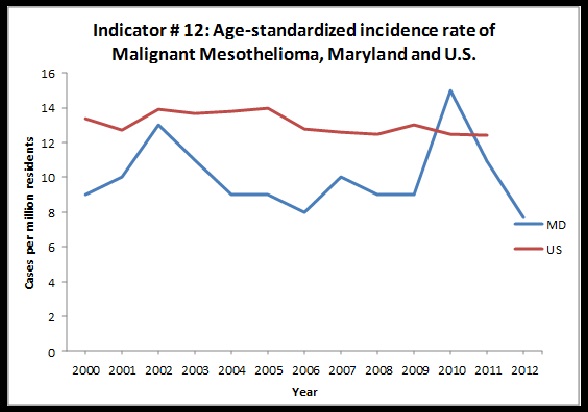Indicator #12: Incidence of Malignant Mesothelioma

Malignant mesothelioma is a rare but highly fatal cancer of the thin membranes surrounding the chest cavity (pleura) or abdominal cavity (peritoneum). Much less frequently, this tumor affects other sites (e.g., pericardium). The only well-established risk factor for mesothelioma is exposure to asbestos fibers. Prior asbestos exposure, primarily from exposure in the workplace, has been reported in 62 to 85 percent of all mesothelioma cases.
Graph

Table
Indicator # 12: Cases of Malignant Mesothelioma, Maryland
| Year | Number | Rate* | Age-Standardized Incidence Rate* |
|---|
*Cases per million residents
|
| 2000 | 47 | 11.3 | 9.0
|
| 2001 | 51 | 12.0 | 10.0 |
| 2002 | 64 | 14.9 | 13.0 |
| 2003 | 57 | 13.1 | 11.0 |
| 2004 | 48 | 10.9 | 9.0 |
| 2005 | 46 | 10.3 | 9.0 |
| 2006 | 44 | 9.8 | 8.0 |
| 2007 | 57 | 12.6 | 10.0 |
| 2008 | 50 | 11.0 | 9.0 |
| 2009 | 42 | 10.1 | 9.0 |
| 2010 | 70 | 15.0 | 15.0 |
| 2011 | 65 | 13.8 | 10.9 |
| 2012 | 46 | 9.6 | 7.7 |
2013
| 45
| 9.3
| 7.2
|
2014
| 49
| 10.1
| 7.5
|
2015
| 47
| 9.6 | 7.1
|
2016
| 38
| 7.8
| 5.5
|
2017
| 62
| 12.6
| 9.1
|
2018
| 41
| 8.3
| 5.5
|
2019
| 55
| 11.1
| 7.6
|
2020
| 40
| 6.8
| 5.4
|
More about this Indicator
Why is this indicator important?
Malignant mesothelioma, while relatively rare, is a fatal cancer largely attributable to workplace exposure to asbestos. Tracking of malignant mesothelioma should be undertaken to document the burden of occupational disease, to design, target, and evaluate the impact of prevention efforts over time, and to identify previously unrecognized settings in which workers may continue to be at risk of asbestos exposure.
Data Source for this Indicator
SEERStat Static data (Numbers of mesothelioma cases); U.S. Census Bureau (population statistics to calculate rates).
U.S. data and information about this indicator obtained fromhttp://www.cste.org/general/custom.asp?page=OHIndicators
Limitation of Indicator:
Not all cases of malignant mesothelioma are caused by occupational exposures. Because cancer is a disease of long latency, current incidence is not indicative of current exposures and it may be many years before reductions in occupational exposures affect incidence. State of residence of the decedent may not have been the state of exposure.

